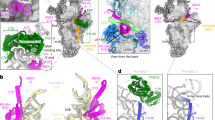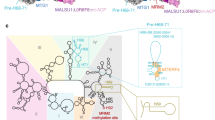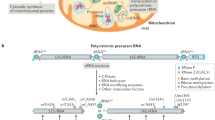Abstract
Oxidative phosphorylation (OXPHOS) is vital for the regeneration of the vast majority of ATP in eukaryotic cells1. OXPHOS is carried out by large multi-subunit protein complexes in the cristae membranes, which are invaginations of the mitochondrial inner membrane. The OXPHOS complexes are a mix of subunits encoded in the nuclear and mitochondrial genomes. Thus, the assembly of these dual-origin complexes is an enormous logistical challenge for the cell. Using super-resolution microscopy (nanoscopy) and quantitative cryo-immunogold electron microscopy, we determined where specific transcripts are translated and where distinct assembly steps of the dual-origin complexes in the yeast Saccharomyces cerevisiae occur. Our data indicate that the mitochondrially encoded proteins of complex III and complex IV are preferentially inserted in different sites of the inner membrane than those of complex V. We further demonstrate that the early, but not the late, assembly steps of complex III and complex IV occur preferentially in the inner boundary membrane. By contrast, all steps of complex V assembly occur mainly in the cristae membranes. Thus, OXPHOS complex assembly is spatially well orchestrated, probably representing an unappreciated regulatory layer in mitochondrial biogenesis.
This is a preview of subscription content, access via your institution
Access options
Access Nature and 54 other Nature Portfolio journals
Get Nature+, our best-value online-access subscription
$29.99 / 30 days
cancel any time
Subscribe to this journal
Receive 12 print issues and online access
$209.00 per year
only $17.42 per issue
Buy this article
- Purchase on Springer Link
- Instant access to full article PDF
Prices may be subject to local taxes which are calculated during checkout





Similar content being viewed by others
References
Friedman, J. R. & Nunnari, J. Mitochondrial form and function. Nature 505, 335–343 (2014).
Muhleip, A. W. et al. Helical arrays of U-shaped ATP synthase dimers form tubular cristae in ciliate mitochondria. Proc. Natl Acad. Sci. USA 113, 8442–8447 (2016).
Enriquez, J. A. Supramolecular organization of respiratory complexes. Annu. Rev. Physiol. 78, 533–561 (2016).
Wurm, C. A. & Jakobs, S. Differential protein distributions define two sub-compartments of the mitochondrial inner membrane in yeast. FEBS Lett. 580, 5628–5634 (2006).
Vogel, F., Bornhovd, C., Neupert, W. & Reichert, A. S. Dynamic subcompartmentalization of the mitochondrial inner membrane. J. Cell Biol. 175, 237–247 (2006).
Wilkens, V., Kohl, W. & Busch, K. Restricted diffusion of OXPHOS complexes in dynamic mitochondria delays their exchange between cristae and engenders a transitory mosaic distribution. J. Cell Sci. 126, 103–116 (2013).
Fox, T. D. Mitochondrial protein synthesis, import, and assembly. Genetics 192, 1203–1234 (2012).
Couvillion, M. T., Soto, I. C., Shipkovenska, G. & Churchman, L. S. Synchronized mitochondrial and cytosolic translation programs. Nature 533, 499–503 (2016).
Dennerlein, S., Wang, C. & Rehling, P. Plasticity of mitochondrial translation. Trends Cell Biol. 27, 712–721 (2017).
Stagge, F., Mitronova, G. Y., Belov, V. N., Wurm, C. A. & Jakobs, S. Snap-, CLIP- and Halo-Tag labelling of budding yeast cells. PLoS ONE 8, e78745 (2013).
Sahl, S. J., Hell, S. W. & Jakobs, S. Fluorescence nanoscopy in cell biology. Nat. Rev. Mol. Cell Biol. 18, 685–701 (2017).
Pfanner, N. et al. Uniform nomenclature for the mitochondrial contact site and cristae organizing system. J. Cell Biol. 204, 1083–1086 (2014).
Tokuyasu, K. T. A technique for ultracryotomy of cell suspensions and tissues. J. Cell Biol. 57, 551–565 (1973).
Suppanz, I. E., Wurm, C. A., Wenzel, D. & Jakobs, S. The m-AAA protease processes cytochrome c peroxidase preferentially at the inner boundary membrane of mitochondria. Mol. Biol. Cell 20, 572–580 (2009).
Stoldt, S. et al. The inner-mitochondrial distribution of Oxa1 depends on the growth conditions and on the availability of substrates. Mol. Biol. Cell 23, 2292–2301 (2012).
Herrmann, J. M., Woellhaf, M. W. & Bonnefoy, N. Control of protein synthesis in yeast mitochondria: the concept of translational activators. Biochim. Biophys. Acta 1833, 286–294 (2013).
Neupert, W. Mitochondrial gene expression: a playground of evolutionary tinkering. Annu. Rev. Biochem. 85, 65–76 (2016).
Ott, M., Amunts, A. & Brown, A. Organization and regulation of mitochondrial protein synthesis. Annu. Rev. Biochem. 85, 77–101 (2016).
Pfeffer, S., Woellhaf, M. W., Herrmann, J. M. & Forster, F. Organization of the mitochondrial translation machinery studied in situ by cryoelectron tomography. Nat. Commun. 6, 6019 (2015).
Prestele, M., Vogel, F., Reichert, A. S., Herrmann, J. M. & Ott, M. Mrpl36 is important for generation of assembly competent proteins during mitochondrial translation. Mol. Biol. Cell 20, 2615–2625 (2009).
Michaelis, U., Korte, A. & Rodel, G. Association of cytochrome b translational activator proteins with the mitochondrial membrane: implications for cytochrome b expression in yeast. Mol. Gen. Genet. 230, 177–185 (1991).
Krause-Buchholz, U., Barth, K., Dombrowski, C. & Rodel, G. Saccharomyces cerevisiae translational activator Cbs2p is associated with mitochondrial ribosomes. Curr. Genet. 46, 20–28 (2004).
Gruschke, S. et al. Cbp3–Cbp6 interacts with the yeast mitochondrial ribosomal tunnel exit and promotes cytochrome b synthesis and assembly. J. Cell Biol. 193, 1101–1114 (2011).
Gruschke, S. et al. The Cbp3–Cbp6 complex coordinates cytochrome b synthesis with bc 1 complex assembly in yeast mitochondria. J. Cell Biol. 199, 137–150 (2012).
Hildenbeutel, M. et al. Assembly factors monitor sequential hemylation of cytochrome b to regulate mitochondrial translation. J. Cell Biol. 205, 511–524 (2014).
Cruciat, C. M., Hell, K., Folsch, H., Neupert, W. & Stuart, R. A. Bcs1p, an AAA-family member, is a chaperone for the assembly of the cytochrome bc 1 complex. EMBO J. 18, 5226–5233 (1999).
Sawamura, R., Ogura, T. & Esaki, M. A conserved alpha helix of Bcs1, a mitochondrial AAA chaperone, is required for the respiratory complex III maturation. Biochem. Biophys. Res. Commun. 443, 997–1002 (2014).
Soto, I. C., Fontanesi, F., Liu, J. & Barrientos, A. Biogenesis and assembly of eukaryotic cytochrome c oxidase catalytic core. Biochim. Biophys. Acta 1817, 883–897 (2012).
Naithani, S., Saracco, S. A., Butler, C. A. & Fox, T. D. Interactions among COX1, COX2, and COX3 mRNA-specific translational activator proteins on the inner surface of the mitochondrial inner membrane of Saccharomyces cerevisiae. Mol. Biol. Cell 14, 324–333 (2003).
Zamudio-Ochoa, A., Camacho-Villasana, Y., Garcia-Guerrero, A. E. & Perez-Martinez, X. The Pet309 pentatricopeptide repeat motifs mediate efficient binding to the mitochondrial COX1 transcript in yeast. RNA Biol. 11, 953–967 (2014).
Perez-Martinez, X., Butler, C. A., Shingu-Vazquez, M. & Fox, T. D. Dual functions of Mss51 couple synthesis of Cox1 to assembly of cytochrome c oxidase in Saccharomyces cerevisiae mitochondria. Mol. Biol. Cell 20, 4371–4380 (2009).
Rak, M., Gokova, S. & Tzagoloff, A. Modular assembly of yeast mitochondrial ATP synthase. EMBO J. 30, 920–930 (2011).
Zeng, X., Hourset, A. & Tzagoloff, A. The Saccharomyces cerevisiae ATP22 gene codes for the mitochondrial ATPase subunit 6-specific translation factor. Genetics 175, 55–63 (2007).
Zeng, X., Barros, M. H., Shulman, T. & Tzagoloff, A. ATP25, a new nuclear gene of Saccharomyces cerevisiae required for expression and assembly of the Atp9p subunit of mitochondrial ATPase. Mol. Biol. Cell 19, 1366–1377 (2008).
Woellhaf, M. W., Sommer, F., Schroda, M. & Herrmann, J. M. Proteomic profiling of the mitochondrial ribosome identifies Atp25 as a composite mitochondrial precursor protein. Mol. Biol. Cell 27, 3031–3039 (2016).
Naumenko, N., Morgenstern, M., Rucktaschel, R., Warscheid, B. & Rehling, P. INA complex liaises the F1Fo-ATP synthase membrane motor modules. Nat. Commun. 8, 1237 (2017).
Gruschke, S. & Ott, M. The polypeptide tunnel exit of the mitochondrial ribosome is tailored to meet the specific requirements of the organelle. Bioessays 32, 1050–1057 (2010).
Kehrein, K. et al. Organization of mitochondrial gene expression in two distinct ribosome-containing assemblies. Cell Rep. 10, 843–853 (2015).
Janke, C. et al. A versatile toolbox for PCR-based tagging of yeast genes: new fluorescent proteins, more markers and promoter substitution cassettes. Yeast 21, 947–962 (2004).
Acknowledgements
We thank A. Kremer and S. Lippens of the VIB BioImaging Core in Ghent, Belgium, for acquisition of the FIB-SEM data. We thank J. Herrmann, TU Kaiserslautern, for providing antisera, B. Westermann, University of Bayreuth, for providing the plasmid pVT100U-mt GFP and S. W. Hell for continuous support. We are grateful to R. Schmitz-Salue and G. Heim for excellent technical assistance and J. Jethwa for proofreading the manuscript. This work was supported by the Swedish Research Council, the Knut and Alice Wallenberg Foundation (both to M.O.), the Cluster of Excellence and DFG Research Center Nanoscale Microscopy and Molecular Physiology of the Brain and the DFG funded SFB1190 (project P01) (both to S.J.).
Author information
Authors and Affiliations
Contributions
S.S., D.W. and D.R. performed the research. S.S., D.W., K.K., D.R., M.O. and S.J. analysed the data. S.S. and S.J. designed the study and coordinated the experimental work. S.J. wrote the manuscript with contributions from all authors. All authors commented on the final manuscript.
Corresponding author
Ethics declarations
Competing interests
The authors declare no competing interests.
Additional information
Publisher’s note: Springer Nature remains neutral with regard to jurisdictional claims in published maps and institutional affiliations.
Integrated supplementary information
Supplementary Figure 1 Distribution of selected proteins along the mitochondrial tubules.
Images of representative mitochondrial segments of ten different yeast cells expressing Cbp3-GFP (a), Coa1-GFP (b), Atp25-GFP (c), mitochondria targeted GFP (mtGFP) (d), Atp4-GFP (e), and Mic60-GFP (f) fusion proteins from the respective endogenous genomic locus (or from a plasmid in case of mtGFP). Cells were immunolabelled with an antiserum against GFP and imaged with STED nanoscopy and diffraction limited confocal microscopy, as indicated. All nanoscopy experiments were done in triplicate, persistently giving similar results. Scale bars: 200 nm
Supplementary Figure 2 The majority of all CM fragments seen on 2D slices are part of larger cristae.
For the analysis, a FIB-SEM data stack recorded on wild type S. cerevisiae cells grown in galactose medium was scrutinized. We recorded one FIB-SEM stack containing several dozen yeast cells and we reconstructed mitochondrial membranes out of three cells, all displaying similar ultrastructures. (a) We define the size of a given crista as the largest contour length of this crista in a 2D section; by this, we will underestimate the size of very large cristae, but will reliably detect all small cristae. To determine the largest contour length of an individual crista, we analyzed 2D sections in a reconstructed 3D FIB-SEM data stack. Only the largest contour length of a crista was used for further analysis. The analysis was performed on mitochondria of two randomly chosen cells, giving similar results. In the example given in (a), the arrowheads point to the same crista in different slices of the FIB-SEM data stack. The contour length of the crista shown in slice 216 (marked in magenta) is used to characterize this crista. (The mitochondrial outer membrane is depicted in orange, the CMs in green). (b) Distribution of measured largest contour lengths of cristae. 112 cristae in two different cells were analyzed. Note that only ~6 % (7 in 112 cristae) were smaller than 50 % of the median. We define these cristae as small cristae. (c) The contour lengths of the cristae were arranged into classes and the frequency of these classes is shown. (d) A part of the mitochondrial network (21 slices) that incorporates the largest of the small cristae (see a-c) was reconstructed in 3D. The small crista is highlighted in magenta, all other cristae in cyan, the outer mitochondrial membrane in light gray. (e) The CM lengths in the 21 2D slices that lead to the 3D reconstruction shown in (d) were measured. The pie-chart displays the amount of CMs belonging to large cristae (blue) and small cristae (red). Scale bars: 200 nm (a), 100 nm (d)
Supplementary Figure 3 The expressed fusion proteins did not exhibit notable degradation.
Shown are Western Blots of whole cell extracts decorated with an antiserum against GFP, as indicated. As a loading control of each western blot, a porin specific serum was used. Outlines indicate different exposure times that were used to ensure optimal signal to noise ratios for proteins with different expression levels on the same blot. All experiments were repeated at least two times with similar results. The full blots are shown in Supplementary Figure 6
Supplementary Figure 4 Genomic tagging of the proteins of interest with GFP did not influence respiration.
Ten-fold dilutions of logarithmically growing cells with the indicated genotypes were spotted onto agar plates containing glucose (YPD; fermentable), glycerol (YPG; non-fermentable) or glycerol/ethanol (SGE; non-fermentable) as the carbon sources. All experiments were repeated at least two times with similar results. The plates were incubated for 4 d at 30 °C before photography
Supplementary Figure 5 Quantitative immuno-gold EM of mitochondrial proteins on cryo-sectioned cells.
Shown are representative EM images (right) and the quantifications taken from a larger number of images (left). The distributions of Cor1 and Cox2 were determined with antiserum against these proteins; all other sections were decorated with antiserum against GFP. Cells were grown at 30 °C in galactose containing medium. The arrowheads point to gold particles at the IBM (black) or at the CM (grey). For each analyzed protein localization, at least three individual slices were decorated and analyzed; n indicates the number of analyzed gold particles. Scale bars: 100 nm
Supplementary Figure 6 Unprocessed blot images of Supplementary Figure 3.
(a-i) corresponds to the labelling in Supplementary Figure 3. Reflected light images of the blot membranes containing the size marker are combined with the camera images of the recorded enhanced chemiluminescence (ECL) signals. Membranes were not cut
Supplementary information
Supplementary Information
Supplementary Figures 1–6, Supplementary Table and Supplementary Video legends, and Supplementary References.
Supplementary Table 1
Proteins investigated in this study and their role in mitochondrial translation and OXPHOS assembly.
Supplementary Table 2
Primary antibodies used in this study.
Supplementary Table 3
Primers used for epitope tagging and gene knockouts.
Supplementary Video 1
Mitochondrial inner architecture.
Rights and permissions
About this article
Cite this article
Stoldt, S., Wenzel, D., Kehrein, K. et al. Spatial orchestration of mitochondrial translation and OXPHOS complex assembly. Nat Cell Biol 20, 528–534 (2018). https://doi.org/10.1038/s41556-018-0090-7
Received:
Accepted:
Published:
Issue Date:
DOI: https://doi.org/10.1038/s41556-018-0090-7
This article is cited by
-
MICU1 controls spatial membrane potential gradients and guides Ca2+ fluxes within mitochondrial substructures
Communications Biology (2022)
-
Nanoscopic quantification of sub-mitochondrial morphology, mitophagy and mitochondrial dynamics in living cells derived from patients with mitochondrial diseases
Journal of Nanobiotechnology (2021)
-
Analysing the mechanism of mitochondrial oxidation-induced cell death using a multifunctional iridium(III) photosensitiser
Nature Communications (2021)
-
Mapping protein interactions in the active TOM-TIM23 supercomplex
Nature Communications (2021)
-
Colocalization for super-resolution microscopy via optimal transport
Nature Computational Science (2021)



